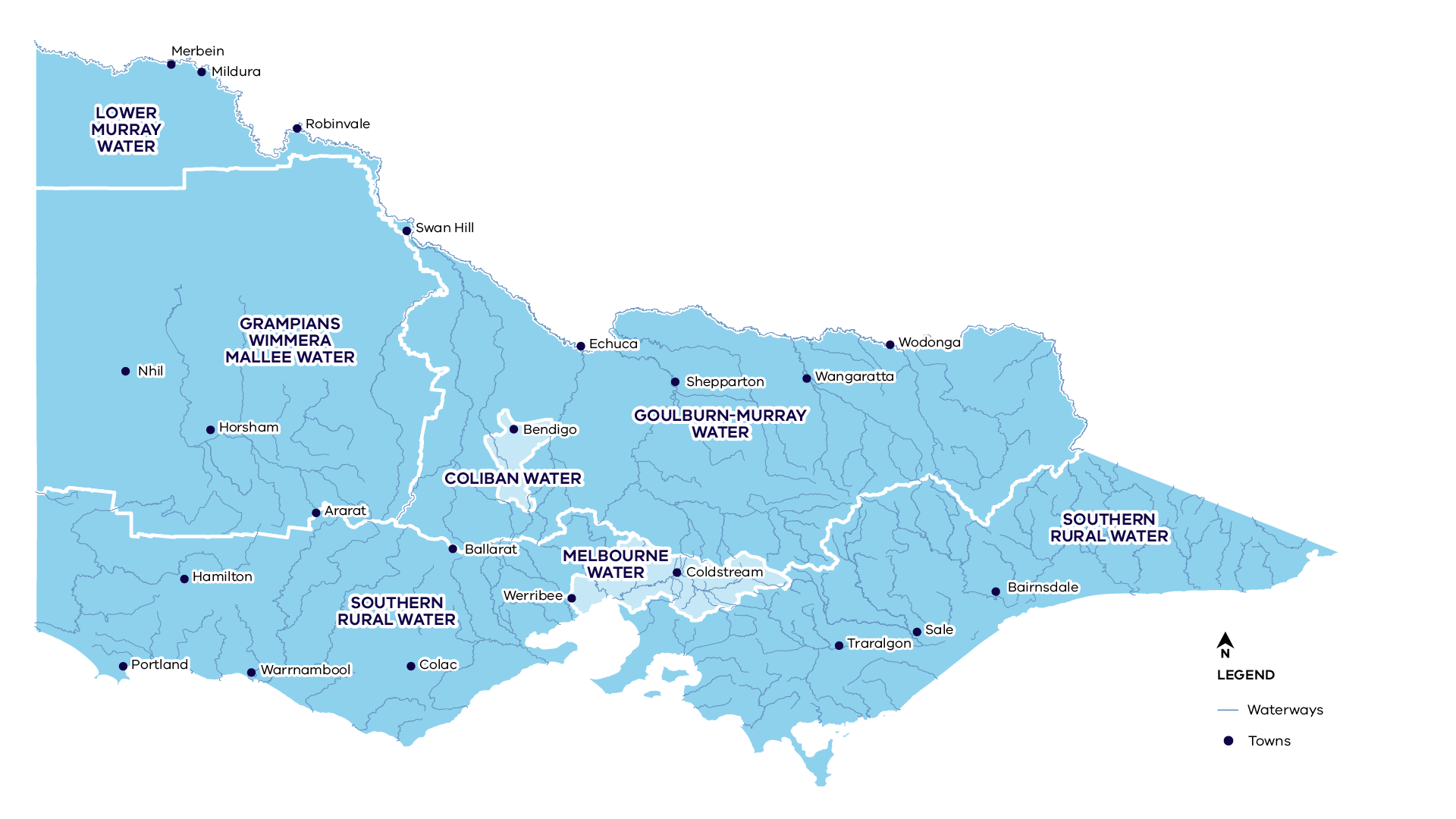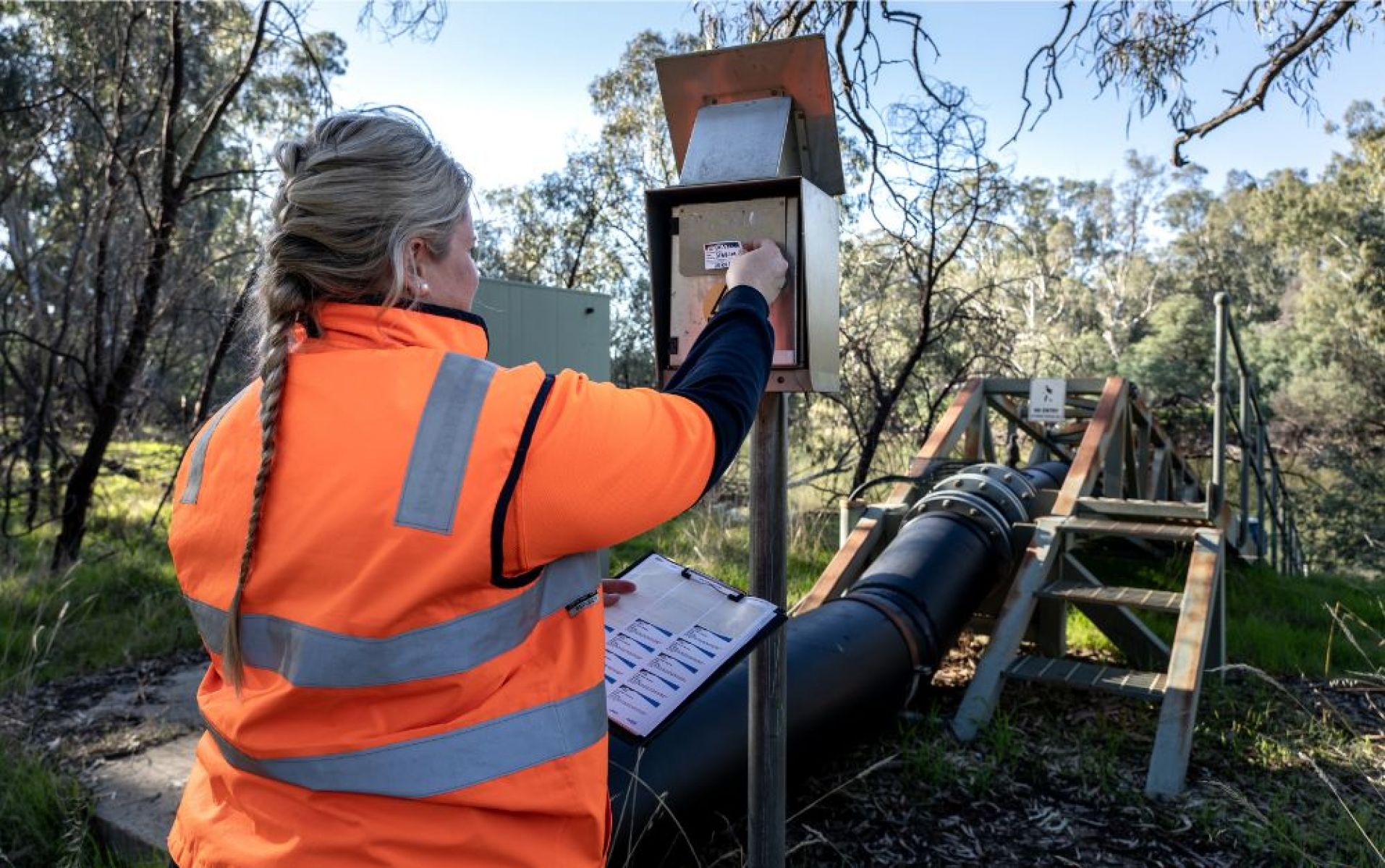On this page:
Non-urban water metering in Victoria
Non-urban metering is essential for comprehensive water accounting and sustainable water management. In Victoria, water corporations with rural customers own, maintain and read meters.
Water corporations are responsible for making decisions about whether a meter is needed and for selecting metering and telemetry devices. Victoria’s Non-urban Water Metering Policy guides water corporations in making these decisions.
In these reports, water corporations refers to:
- Goulburn-Murray Water
- Lower Murray Water
- Grampians Wimmera Mallee Water
- Coliban Water
- Melbourne Water
- Southern Rural Water.
Victoria’s six rural water corporations

Metering policy implementation reporting
Victoria publishes an annual non-urban metering implementation report on metering reform. These reports meet Victoria’s continuing obligation to monitor and report on Victoria’s progress in implementing non-urban water metering.
Victoria’s non-urban water metering policy (PDF, 1.8 MB), in accordance with the Murray-Darling Basin Compliance Compact (2018) sets requirements for water corporations and its rural customers to prepare and maintain metering action plans.
Victoria’s metering policy details accuracy and measurement targets which are annually reported on:
- Existing and new metering sites should be fitted with meters that conform with AS4747 standard
- All metered water take must be telemetered, where benefits outweigh costs
- Manual meter reading may be retained where telemetry is not viable
More information can be found on the Non-urban water metering page.
Metering terminology
The following terms are utilised within the reports:
Term | Definition |
AS4747 meter | a water meter that conforms with AS4747, that has been either pattern approved or verified to meet the processes and procedures outlined in AS4747 – Meters for Non-Urban Water Supply (Standards Australia, 2013). |
Contemporary standard | also known as interim standard, are water meters that are contemporary at the time they were installed. This means the meter installed is likely to meet the ±5% accuracy range set by the National Framework for Non-Urban Metering (2009) and which has a manufacturer’s certificate of accuracy of ±2.5% and has been installed to manufacturer’s specifications. |
Exempt meter | a water meter that does not conform with AS4747 or meet contemporary standards and has been exempt from metering upgrade requirements. A meter may be exempted in certain circumstances described in Victoria’s non-urban water metering policy (e.g., small volume take, domestic and stock use, cost outweighs compliance benefit). |
Non-compliant meter | a water meter that currently does not meet pattern approval, ±5% accuracy range or conform with AS4747 standards. These meters have not been exempted and need to be upgraded to conform with AS4747 requirements. |
Telemetry | a device that involves automatically recording data and sending it electronically from the meter to another place for monitoring and recording. |
Unmetered (estimated use) | water take is estimated where a customer service point may not be metered. Meter requirements may be exempted in certain circumstances described in Victoria’s non-urban water metering policy (e.g., small volume take, domestic and stock use). |
Snapshot of metering implementation in Victoria
Over the past 20 years, Victoria has made major investments in metering. By installing thousands of meters and implementing the Victorian non-urban water metering policy, Victoria now has Australia’s largest fleet of modern meters.
As of 30 June 2024, Victoria has 51,117 non-urban water meters, including 30,878 fitted with telemetry devices.
Non-urban water metering systems and assets
Victorian water corporations are early adopters of non-urban water metering and national leaders in telemetry and automated control systems.
The National Measurement Institute approved the first meter for full flowing pipes as conforming with the AS4747 standard (pattern-approved) in 2014. Majority of meters in Victoria were installed before 2014, which means meters that conform with AS4747 make up a relatively smaller portion of the state’s metering fleet. DEECA and water corporations are working to increase the uptake of more AS4747 meters and telemetry.
Note: In 2020-21, the number of meters reported included small volume domestic and stock customers where exemptions for metering apply, and usage is deemed. In 2023-24, water corporations continued to improve their reporting systems and decommissioned sites resulting in an observed reduction in metered sites across the state.
Telemetry uplift in Victoria
Victoria is working towards increasing its telemetry coverage across the state. Increasing the number of telemetry devices across Victoria and the Murray-Darling Basin ensures that water taken is accurately measured, and any unauthorised use of water is closely monitored.
Where telemetry has not been installed, water corporation officers read meters to check that no one is using more water than their water share or licence allows.

Annual metering implementation reports
Victoria annually reports on non-urban metering implementation across the state.
Murray-Darling Basin Metering Report Card
The Inspector-General of Water Compliance reports on metering reform across the Murray-Darling Basin each year.
Page last updated: 07/03/25
